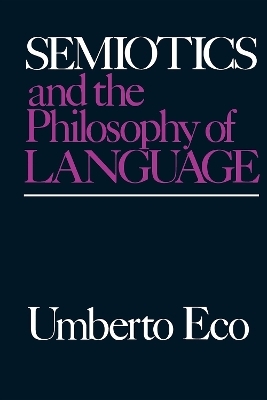
Semiotics and the Philosophy of Language
Indiana University Press (Verlag)
978-0-253-20398-4 (ISBN)
Introduction 1. Signs 1.1. Crisis of a concept 1.2. The signs of an obstinacy 1.3. Intension and extension 1.4. Elusive solutions 1.5. The deconstruction of the linguistic sign 1.6. Signs vs. words 1.7. The stoics 1.8. Unification of the theories and the predominance of linguistics 1.9. The 'instructional' model 1.10. Strong codes and weak codes 1.11. Abduction and inferential nature of signs 1.12. The criterion of interpretability 1.13. Sign and subject 2. Dictionary vs. Encyclopedia 2.1. Porphyry strikes back 2.2 Critique of the Porphyrian tree 2.3. Encyclopedias 3. Metaphor 3.1. The metaphoric nexus 3.2. Traditional definitions 3.3. Aristotle: synecdoche and Porphyrian tree 3.4. Aristotle: metaphors of three terms 3.5. Aristotle: the proportional scheme 3.6. Proportion and condensation 3.7. Dictionary and encyclopedia 3.8. The cognitive function 3.9. The semiosic background: the system of content 3.10. The limits of formalization 3.11. Componential representation and the pragmatics of the text 3.12. Conclusions 4. Symbol 4.1. Genus and species 4.2. Expressions by ratio facilis 4.3. Expressions produced by ratio difficilis 4.4. The symbolic mode 4.5. Semiotics of the symbolic mode 4.6. Conclusions 5. Code 5.1. The rise of new category 5.2. The landslide effect 5.3. Codes and communication 5.4. Codes as s-codes 5.5. Cryptography and natural languages 5.6. S-codes and signification 5.7 The genetic code 5.8. Toward a provisonal conclusion 6. Isotopy 6.1. Discursive isotopies within sentences with paradigmatic disjunction 6.2. Discursive isotopies within sentences with syntagmatic disjunction 6.3. Discursive isotopies between sentences with paradigmatic disjunction 6.4. Discursive isotopies between sentences with syntagmatic disjunction 6.5. Narrative isotopies connected with isotopic discursive disjunctions generating mutually exlusive stories 6.6 Narrative isotopies connected with isotopic discursive disjunctions that generate complementary stories 6.7. Narrative isotopies connected with discursive isotopic disjunctions that generate complementary stoies in each case 6.8. Extensional isotopies 6.9. Provisional conclusions 7. Mirrors 7.1. Is the mirror image a sign? 7.2. The imaginary and the symbolic 7.3. Getting in through the Mirror 7.4. A phenomenology of the mirror: the mirror does not invert 7.5. A pragmatics of the mirror 7.6. The mirror as a prosthesis and a channel 7.7. Absolute icons 7.8. Mirrors as rigid designators 7.9. On signs 7.10. Why mirrors do not produce signs 7.11. Freaks: distorting mirrors 7.12. Procatoptric staging 7.13. Rainbows and Fata Morganas 7.14. Catoptric theaters 7.15. Mirrors that 'freeze' images 7.16. The experimentum crucis References Index of authors Index of subjects
| Erscheint lt. Verlag | 22.7.1986 |
|---|---|
| Reihe/Serie | Advances in Semiotic |
| Verlagsort | Bloomington, IN |
| Sprache | englisch |
| Maße | 155 x 235 mm |
| Themenwelt | Geisteswissenschaften ► Philosophie ► Erkenntnistheorie / Wissenschaftstheorie |
| Geisteswissenschaften ► Philosophie ► Sprachphilosophie | |
| Geisteswissenschaften ► Sprach- / Literaturwissenschaft ► Sprachwissenschaft | |
| Sozialwissenschaften | |
| ISBN-10 | 0-253-20398-8 / 0253203988 |
| ISBN-13 | 978-0-253-20398-4 / 9780253203984 |
| Zustand | Neuware |
| Haben Sie eine Frage zum Produkt? |
aus dem Bereich

![Was heißt Denken?. Vorlesung Wintersemester 1951/52. [Was bedeutet das alles?] - Martin Heidegger](/media/113619842)
